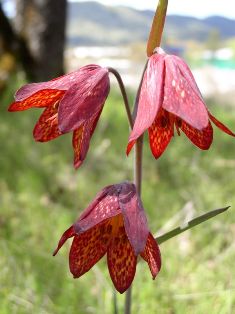Gentner's fritillary facts for kids
Quick facts for kids Gentner's fritillary |
|
|---|---|
 |
|
| Conservation status | |
| Scientific classification | |
| Kingdom: | |
| (unranked): | |
| (unranked): | |
| Order: | |
| Family: | |
| Genus: |
Fritillaria
|
| Species: |
F. gentneri
|
| Binomial name | |
| Fritillaria gentneri |
|
Fritillaria gentneri, also known as Gentner's fritillary, is a very rare flower from the lily family. It grows only in a small area of southwest Oregon and nearby Siskiyou County, California.
This special plant likes dry, open forests and chaparral (a type of shrubland). It grows at elevations from about 1,000 to 5,000 feet high. Gentner's fritillary usually blooms from March to July, but most of its flowers are gone by the end of May. Just like many other plants, those growing in lower, warmer places bloom earlier. The flowers at higher, cooler elevations bloom later.
Contents
Discovering a New Flower
Who Found It?
Gentner's fritillary was first discovered in 1942 by an 18-year-old named Laura Gentner. She found it in a rural part of Jackson County, Oregon.
Naming the Plant
Later, Dr. Helen Margaret Gilkey, who was in charge of the plant collection (called an herbarium) at Oregon State University, studied the flower. She decided it was a brand new species! In 1951, she officially named it Fritillaria gentneri after Laura Gentner, who had found it.
Dr. Gilkey explained how this new flower was different from a similar one called Fritillaria recurva. She wrote that even though both flowers are bright red, Gentner's fritillary has a different shade of red. It also starts blooming about two weeks later and is usually a stronger, bigger plant.
What Does It Look Like?
Plant Features
Gentner's fritillary can grow quite tall, from about 50 to 70 centimeters (that's about 20 to 28 inches). It has reddish flowers that hang down and have a checkered pattern of yellow. The flower petals (called tepals) have tips that bend backward. Its stems are a bit bluish-green (called glaucous) and have groups of leaves arranged in circles, like a whorl.
How to Tell It Apart
It can be a bit tricky to tell Gentner's fritillary apart from Fritillaria recurva. However, you can often spot the difference by looking at its style (part of the flower's female reproductive organ), which spreads out more. It also has longer, more noticeable glands. Plus, the tips of its petals usually don't bend back as much as those on F. recurva.
For a while, scientists weren't sure if this plant was truly its own species. Some even thought it might be a mix, or a hybrid, of two other Fritillaria plants: Fritillaria affinis and Fritillaria recurva. But for now, it is officially listed as its own species in important plant guides like the Flora of North America.
An Endangered Flower
Why It's in Danger
Because Gentner's fritillary is so rare, the U.S. Fish and Wildlife Service listed it as an endangered species in 1999. This means it's at high risk of disappearing forever.
There are only about 30 known groups of these plants left. Most of them (28) are in Oregon, and just two are across the border in California. These groups are very small, with some having only a few individual plants. In total, there are no more than 1,200 Gentner's fritillary plants left in the world.
Helping the Flower Survive
The city of Jacksonville, Oregon is working hard to protect this special flower. They have set aside over 300 acres (about 1.2 square kilometers) of land just for Gentner's fritillary. Every April, Jacksonville even hosts a festival to celebrate the flower! The city also has hiking trails where visitors can enjoy seeing these and other wildflowers.
Plan for Recovery
What is a Recovery Plan?
To help Gentner's fritillary survive and thrive, a special "Recovery Plan" was created on July 21, 2003. This plan divides the areas where the plant grows into four main "recovery units." These units are named Jacksonville, Grants Pass, Butte Falls, and Cascade-Siskiyou National Monument.
Goals for the Future
The Recovery Plan has clear goals to help the plant recover. Here are some of the main conditions:
- To consider the species less endangered (called "downlisting"), each of the four recovery units should have 750 flowering plants. To remove it from the endangered list completely ("delisting"), each unit needs 1,000 flowering plants.
- Special areas for managing Fritillaria plants should be created on public lands or private lands that are protected.
- Each recovery unit should have at least two management areas, with at least 100 flowering plants in each, located close to each other.
- The flowering plants should be spread out over a large area (at least 50,000 square meters or about 12.4 acres) in each unit. This helps protect them from problems that could affect a small, crowded group.
- Each management area needs its own plan for how to care for the plants and check on them regularly.
- Some areas might need fences, special grazing rules for animals, or other actions to protect the plants from threats.
- Once the plant is no longer endangered, there must be a plan in place to keep checking on it to make sure it stays healthy.


